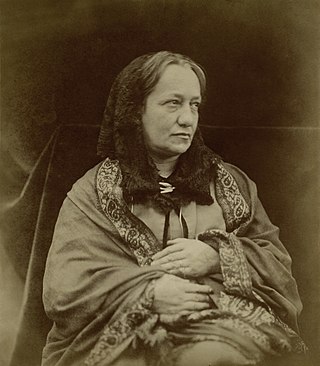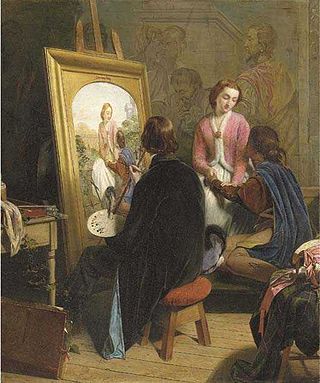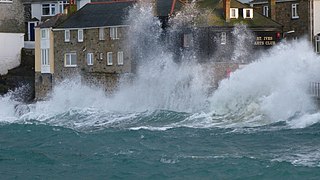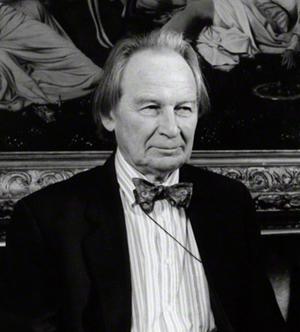
Highgate Cemetery is a place of burial in north London, England, designed by architect Stephen Geary. There are approximately 170,000 people buried in around 53,000 graves across the West and East Cemeteries. Highgate Cemetery is notable both for some of the people buried there as well as for its de facto status as a nature reserve. The Cemetery is designated Grade I on the Register of Historic Parks and Gardens.

Julia Margaret Cameron was a British photographer who is considered one of the most important portraitists of the 19th century. She is known for her soft-focus close-ups of famous Victorians and for illustrative images depicting characters from mythology, Christianity, and literature.

The Pre-Raphaelite Brotherhood was a group of English painters, poets, and art critics, founded in 1848 by William Holman Hunt, John Everett Millais, Dante Gabriel Rossetti, William Michael Rossetti, James Collinson, Frederic George Stephens and Thomas Woolner who formed a seven-member "Brotherhood" partly modelled on the Nazarene movement. The Brotherhood was only ever a loose association and their principles were shared by other artists of the time, including Ford Madox Brown, Arthur Hughes and Marie Spartali Stillman. Later followers of the principles of the Brotherhood included Edward Burne-Jones, William Morris and John William Waterhouse.

The Royal Academy of Arts (RA) is an art institution based in Burlington House in Piccadilly in London, England. Founded in 1768, it has a unique position as an independent, privately funded institution led by eminent artists and architects. Its purpose is to promote the creation, enjoyment and appreciation of the visual arts through exhibitions, education and debate.

The Art of the United Kingdom refers to all forms of visual art in or associated with the United Kingdom since the formation of the Kingdom of Great Britain in 1707 and encompasses English art, Scottish art, Welsh art and Irish art, and forms part of Western art history. During the 18th century, Britain began to reclaim the leading place England had previously played in European art during the Middle Ages, being especially strong in portraiture and landscape art.

The Clique was a group of English artists formed by Richard Dadd in the late 1830s. Other members were Augustus Egg, Alfred Elmore, William Powell Frith, Henry Nelson O'Neil, John Phillip and Edward Matthew Ward.

Augustus Leopold Egg RA was a British Victorian artist, and member of The Clique best known for his modern triptych Past and Present (1858), which depicts the breakup of a middle-class Victorian family.
A clique is a close social group.

William Frederick Yeames was a British painter best known for his oil-on-canvas "And When Did You Last See Your Father?", which depicts the son of a Royalist being questioned by Parliamentarians during the English Civil War.

Peter Benjamin Graham was an Australian visual artist, printer, and art theorist.

David Wilkie Wynfield was a British painter and photographer who gained recognition for his historical genre paintings and his pioneering use of shallow-focus portrait photography.

George Adolphus Storey was an English portrait painter, genre painter and illustrator.

The St Ives School refers to a group of artists living and working in the Cornish town of St Ives. The term is often used to refer to the 20th century groups which sprung up after the First World War around such artists as Borlase Smart, however there was considerable artistic activity there from the late 19th Century onwards.

Henry Stacy Marks was a British artist who took a particular interest in Shakespearean and medieval themes in his early career and later in decorative art depicting birds and ornithologists as well as landscapes. Most of his early works were oils but he also worked on murals and with watercolours. He was a founding member of the St John's Wood Clique and was well known for his humorous performances.

George Dunlop Leslie was a British genre painter, author and illustrator.

Amy Dora Reynolds, under the pen name of Mrs. Fred Reynolds, was a poet and author of crime and romance novels in the late 19th- and early 20th-century.

The Williams family of painters, also known as the Barnes School, is a family of prominent 19th-century Victorian landscape artists known for their paintings of the British countryside, coasts and mountains. They are represented by the artist Edward Williams (1781–1855), his six sons, and several grandchildren.

Florence St John Cadell was a Scottish artist and patriot, involved in the early days of the Scottish National Party with her friend Wendy Wood. Her artworks are usually signed St John Cadell, disguising her femininity.

Arthur Graham Reynolds,, was an English art historian who was Keeper of Paintings at the Victoria and Albert Museum. He was a leading expert on portrait miniatures and the art of John Constable, for whose works he wrote the catalogue raisonné. Reynolds's approach exemplified traditional scholarship and connoisseurship and he was fiercely opposed to the New Art History of the 1970s.
Sir John Francis Fortescue Horner, was a British barrister. His family had lived at Mells Manor for generations and many have memorials in St Andrew's Church, Mells. He and his family became associated with The Souls, a social group which included many of the most distinguished English politicians and intellectuals of the Victorian era.



















